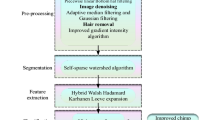Abstract
Levenberg-Marquardt method is a very useful tool for solving nonlinear curve fitting problems; while it is also a very promising alternative of weight adjustment in feed forward neural networks. Forcing the Hessian matrix to stay positive definite, the parameter \( \uplambda \) also turns the algorithm into the well-known variations: steepest-descent and Gauss-Newton. Given the computation time, the results achieved by these methods surely differ while minimizing the sum of squares of errors and with an acceptable accuracy rate in skin tissue recognition. Therefore in this paper, we propose the implementation of these variations in network training by a set of tissue samples borrowed from SFA human skin database. The RGB images taken from the set are converted into YCbCr color space and the networks are individually trained by these methods to create weight arrays minimizing the error squares between the pixel values and the function output. Consisting of hands on computer keyboards, the images are analyzed to find skin tissues for achieving high accuracy with low computation time and for comparison of the methods.
Access this chapter
Tax calculation will be finalised at checkout
Purchases are for personal use only
Similar content being viewed by others
References
Levenberg, K.: A method for the solution of certain non-linear problems in least squares. Q. Appl. Math. 2, 164–168 (1944)
Ibrahimy, M.I., Ahsan, M.R., Khalifa, O.O.: Design and optimization of Levenberg-Marquardt based neural network classifier for EMG signals to identify hand motions. Measur. Sci. Rev. 13(3), 142–151 (2013)
Kermani, B.G., Schiffman, S.S., Nagle, H.T.: Performance of the Levenberg–Marquardt neural network training method in electronic nose applications. Sens. Actuators 110, 13–22 (2005)
Alpar, O.: Keystroke recognition in user authentication using ANN based RGB histogram technique. Eng. Appl. Artif. Intell. 32, 213–217 (2014)
Alpar, O.: Intelligent biometric pattern password authentication systems for touchscreens. Expert Syst. Appl. 42(17–18), 6286–6294 (2015)
Schweiger, M., Arridge, S.R., Nissila, I.: Gauss-Newton method for image reconstruction in diffuse optical tomography. Phys. Med. Biol. 50, 2365–2386 (2005)
Rubæk, T., Meaney, P.M., Meincke, P., Paulsen, K.D.: Nonlinear microwave imaging for breast-cancer screening using Gauss–Newton’s method and the CGLS inversion algorithm. IEEE Trans. Antennas Propag. 55(8), 2320–2331 (2007)
Tanner, J., Wei, K.: Low rank matrix completion by alternating steepest descent methods. Appl. Comput. Harmon. Anal. 40, 417–429 (2016)
Fiori, S.: A Riemannian steepest descent approach over the inhomogeneous symplectic group: application to the averaging of linear optical systems. Appl. Math. Comput. 283, 251–264 (2016)
Kolkur, S., Kalbande, D., Shimpi, P., Bapat, C., Jatakia, J.: Human skin detection using RGB, HSV and YCbCr color models. Adv. Intell. Syst. Res. 137, 324–332 (2017)
Mandal, A.K., Baruah, D.K.: Image segmentation using local thresholding and YCbCr color space. Int. J. Eng. Res. Appl. 3(6), 511–514 (2013)
Casati, J.P.B., Moraes, D.R., Rodrigues, E.L.L.: SFA: a human skin image database based on FERET and AR facial images. In: 2013 IX Workshop de Visão Computacional, Rio de Janeiro, Anais do VIII Workshop de Visão Computacional (2013)
Alpar, O., Krejcar, O.: Detection of irregular thermoregulation in hand thermography by fuzzy C-means. In: Rojas, I., Ortuño, F. (eds.) IWBBIO 2018. LNCS, vol. 10814, pp. 255–265. Springer, Cham (2018). https://doi.org/10.1007/978-3-319-78759-6_24
Alpar, O., Krejcar, O.: Superficial dorsal hand vein estimation. In: Rojas, I., Ortuño, F. (eds.) IWBBIO 2017. LNCS, vol. 10208, pp. 408–418. Springer, Cham (2017). https://doi.org/10.1007/978-3-319-56148-6_36
Alpar, O., Krejcar, O.: A new feature extraction in dorsal hand recognition by chromatic imaging. In: Nguyen, N.T., Tojo, S., Nguyen, L.M., Trawiński, B. (eds.) ACIIDS 2017. LNCS (LNAI), vol. 10192, pp. 266–275. Springer, Cham (2017). https://doi.org/10.1007/978-3-319-54430-4_26
Kirimtat, A., Krejcar, O.: Parametric variations of anisotropic diffusion and gaussian high-pass filter for NIR image preprocessing in vein identification. In: Rojas, I., Ortuño, F. (eds.) IWBBIO 2018. LNCS, vol. 10814, pp. 212–220. Springer, Cham (2018). https://doi.org/10.1007/978-3-319-78759-6_20
Sarabakha, A., Imanberdiyev, N., Kayacan, E., Khanesar, M.A., Hagras, H.: Novel Levenberg–Marquardt based learning algorithm for unmanned aerial vehicles. Inf. Sci. 417, 361–380 (2017)
Amini, K., Rostami, F.: Three-steps modified Levenberg–Marquardt method with a new line search for systems of nonlinear equations. J. Comput. Appl. Math. 300, 30–42 (2016)
Amini, K., Rostami, F.: A modified two steps Levenberg–Marquardt method for nonlinear equations. J. Comput. Appl. Math. 288, 341–350 (2015)
Iqbal, J., Iqbal, A., Arif, M.: Levenberg–Marquardt method for solving systems of absolute value equations. J. Comput. Appl. Math. 282, 134–138 (2015)
Acknowledgement
The work and the contribution were supported by the SPEV project “Smart Solutions in Ubiquitous Computing Environments”, University of Hradec Kralove, Faculty of Informatics and Management, Czech Republic (under ID: UHK-FIM-SPEV-2019).
Author information
Authors and Affiliations
Corresponding author
Editor information
Editors and Affiliations
Rights and permissions
Copyright information
© 2019 Springer Nature Switzerland AG
About this paper
Cite this paper
Kirimtat, A., Krejcar, O., Selamat, A. (2019). Levenberg-Marquardt Variants in Chrominance-Based Skin Tissue Detection. In: Rojas, I., Valenzuela, O., Rojas, F., Ortuño, F. (eds) Bioinformatics and Biomedical Engineering. IWBBIO 2019. Lecture Notes in Computer Science(), vol 11466. Springer, Cham. https://doi.org/10.1007/978-3-030-17935-9_9
Download citation
DOI: https://doi.org/10.1007/978-3-030-17935-9_9
Published:
Publisher Name: Springer, Cham
Print ISBN: 978-3-030-17934-2
Online ISBN: 978-3-030-17935-9
eBook Packages: Computer ScienceComputer Science (R0)




